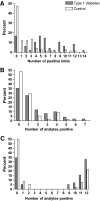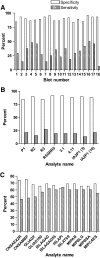Validity and reproducibility of measurement of islet autoreactivity by T-cell assays in subjects with early type 1 diabetes
- PMID: 19675135
- PMCID: PMC2768166
- DOI: 10.2337/db09-0249
Validity and reproducibility of measurement of islet autoreactivity by T-cell assays in subjects with early type 1 diabetes
Abstract
Objective: Type 1 diabetes results from an immunemediated destruction of beta-cells, likely to be mediated by T lymphocytes, but the sensitivity, specificity, and other measures of validity of existing assays for islet autoreactive T-cells are not well established. Such assays are vital for monitoring responses to interventions that may modulate disease progression.
Research design and methods: We studied the ability of cellular assays to discriminate responses in patients with type 1 diabetes and normal control subjects in a randomized blinded study in the U.S. and U.K. We evaluated the reproducibility of these measurements overall and to individual analytes from repeat collections.
Results: Responses in the cellular immunoblot, U.K.-ELISPOT, and T-cell proliferation assays could differentiate patients from control subjects with odds ratios of 21.7, 3.44, and 3.36, respectively, with sensitivity and specificity as high as 74 and 88%. The class II tetramer and U.S. ELISPOT assays performed less well. Despite the significant association of the responses with type 1 diabetes, the reproducibility of the measured responses, both overall and individual analytes, was relatively low. Positive samples from normal control subjects (i.e., false positives) were generally isolated to single assays.
Conclusions: The cellular immunoblot, U.K.-ELISPOT, and T-cell proliferation assays can distinguish responses from patients with type 1 diabetes and healthy control subjects. The limited reproducibility of the measurements overall and of responses to individual analytes may reflect the difficulty in detection of low frequency of antigen-specific T-cells or variability in their appearance in peripheral blood.
Figures



References
-
- Atkinson MA: ADA Outstanding Scientific Achievement Lecture 2004 Thirty years of investigating the autoimmune basis for type 1 diabetes: why can't we prevent or reverse this disease? Diabetes 2005;54:1253–1263 - PubMed
-
- Ellis T, Jodoin E, Ottendorfer E, Salisbury P, She JX, Schatz D, Atkinson MA: Cellular immune responses against proinsulin: no evidence for enhanced reactivity in individuals with IDDM Diabetes 1999;48:299–303 - PubMed
-
- Dosch H, Cheung RK, Karges W, Pietropaolo M, Becker DJ: Persistent T cell anergy in human type 1 diabetes J Immunol 1999;163:6933–6940 - PubMed
-
- Reijonen H, Novak EJ, Kochik S, Heninger A, Liu AW, Kwok WW, Nepom GT: Detection of GAD65-specific T-cells by major histocompatibility complex class II tetramers in type 1 diabetic patients and at-risk subjects Diabetes 2002;51:1375–1382 - PubMed
MeSH terms
Substances
LinkOut - more resources
Full Text Sources
Other Literature Sources
Medical

